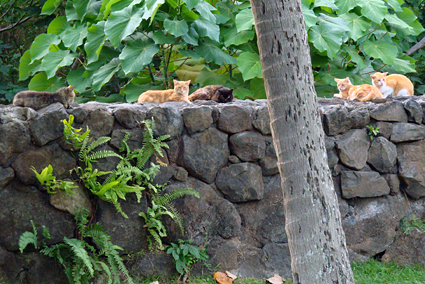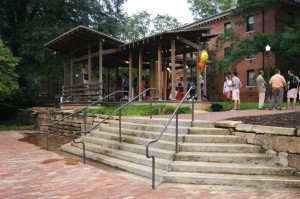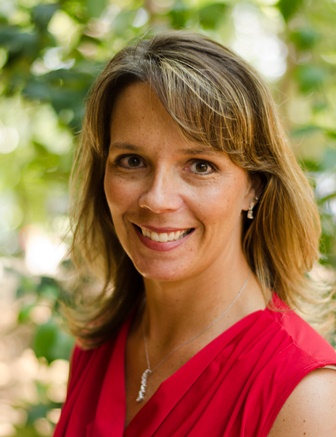The contentious phenomenon of identity politics isn’t limited to Democrats and Republicans. A national survey shows that “cat people” and “bird people” have heated differences of opinion, complicating the challenge of managing more than 50 million free-roaming feral cats while protecting threatened wildlife.
A North Carolina State University study published Sept. 6 in PLOS One identifies why the claws come out over feral cat management and which approaches might be useful in finding common ground among those with polarized opinions.
The research started as a hands-on class project for undergraduate and graduate students in Dr. Nils Peterson‘s Human Dimensions of Wildlife course last year. Team members surveyed 577 people across the U.S. who identified themselves as cat colony caretakers or bird conservation professionals affiliated with groups such as the Audubon Society and American Bird Conservancy.

Cats in a feral colony sun themselves on a wall. Photo courtesy of Alisa Davis, University of Hawaii at Manoa.
“Members of both these groups feel they have concerns that have been ignored,” says Peterson, an associate professor of fisheries, wildlife and conservation biology in the College of Natural Resources. “This feeling of injustice is part of what leads them to identify with their groups.”
Bird conservation professionals, whose focus is on protecting species from extinction in the wild, see feral cats as threats to the survival of wild birds. Cat colony caretakers, on the other hand, dedicate themselves to caring for neighborhood animals they see as abandoned and neglected by others.
The polarized points of view led to wide differences in responses to factual statements about feral cat management and disagreement about the impact of feral cats on wildlife.
Only 9 percent of cat colony caretakers believed cats harmed bird populations, and only 6 percent believed feral cats carried diseases. Colony caretakers supported treating feral cats as protected wildlife and using trap, neuter and release programs to manage feral cat populations.
Many bird conservation professionals, meanwhile, saw feral cats as pests and supported removing and euthanizing them. Within both groups, women and older respondents were less likely to support euthanasia.
“The most surprising result was that cat colony caretakers were more amenable to seeking collaborative solutions to feral cat management than bird conservation professionals,” Peterson says. “Eighty percent of the cat caretakers thought it was possible, while 50 percent of the bird conservationists felt that it was.”
How could the groups take steps to work together in the face of differing opinions about the scientific evidence?
Peterson says part of the solution is getting buy-in. Cat colony caretakers would have to be involved in deciding which data should be collected and how and where it should be done. When possible, participants should be able to see results for themselves rather than relying on reports from another group. One example: observing firsthand that feral cats kill wildlife rather than reading studies that show feral cats contribute to global declines among songbird populations. Another possibility is training cat colony caretakers to recognize parasites or signs of disease in the animals they see regularly, improving the cats’ health and caretakers’ knowledge.
Finally, the groups should recognize they share the common ground of caring about animals. In fact, half of the bird conservation professionals owned and cared for cats. Peterson also hopes his students have gained ideas they can use in dealing with conservation and environmental issues, no matter how contentious.
For more information:
D’Lyn Ford | NC State News Services | 919.513.4798
Nils Peterson | 919/515-7588
– ford –
Note: An abstract of the paper follows.
“Opinions from the Front Lines of Cat Colony Management Conflict”
Authors: M. Nils Peterson, Brett Hartis, Shari Rodriguez, Matthew Green, Christopher Lepczyk Peterson, Hartis, Rodriguez and Green are with North Carolina State University. Lepczyk is with the University of Hawaii at Manoa.
Published: Sept. 6, 2012, in PLOS One
Abstract: Outdoor cats represent a global threat to terrestrial vertebrate conservation, but management has been rife with conflict due to differences in views of the problem and appropriate responses to it. To evaluate these differences we conducted a survey of opinions about outdoor cats and their management with two contrasting stakeholder groups, cat colony caretakers (CCCs) and bird conservation professionals (BCPs) across the United States. Group opinions were polarized, for both normative statements (CCCs supported treating feral cats as protected wildlife and using trap neuter and release [TNR] and BCPs supported treating feral cats as pests and using euthanasia) and empirical statements. Opinions also were related to gender, age, and education, with females and older respondents being less likely than their counterparts to support treating feral cats as pests, and females being less likely than males to support euthanasia. Most CCCs held false beliefs about the impacts of feral cats on wildlife and the impacts of TNR (e.g., 9 percent believed feral cats harmed bird populations, 70 percent believed TNR eliminates cat colonies, and 18 percent disagreed with the statement that feral cats filled the role of native predators. Only 6 percent of CCCs believed feral cats carried diseases. To the extent the beliefs held by CCCs are rooted in lack of knowledge and mistrust, rather than denial of directly observable phenomena, the conservation community can manage these conflicts more productively by bringing CCCs into the process of defining data collection methods, defining study/management locations, and identifying common goals related to caring for animals.
See also: “NCSU study: Partisan claws come out, but compromise possible” News & Observer 9/7/2012
 William Lee, a junior majoring in Environmental Technology and Management, is a Global Ambassador for the nonprofit One Million Lights that distributes solar lights throughout the developing world to improve education, health and the environment. William and the other members of Students for Solar are raising funds for purchasing and distributing 50 solar lights to Terrier Rouge School in rural Haiti. They hope to personally deliver the lights to the school next summer.
William Lee, a junior majoring in Environmental Technology and Management, is a Global Ambassador for the nonprofit One Million Lights that distributes solar lights throughout the developing world to improve education, health and the environment. William and the other members of Students for Solar are raising funds for purchasing and distributing 50 solar lights to Terrier Rouge School in rural Haiti. They hope to personally deliver the lights to the school next summer. The Solar Pavilion project, from which Students for Solar was founded, was the 2010 winner of the Student Government Sustainability Commission‘s Think Outside of the Brick competition. Within two years, a pavilion structure in the courtyard between Welch, Gold, and Syme halls was fitted with a solar array of three panels that now provide renewable energy to two outlets in the pavilion. August 21, 2012 was the Grand Opening of the NC State Solar Pavilion.
The Solar Pavilion project, from which Students for Solar was founded, was the 2010 winner of the Student Government Sustainability Commission‘s Think Outside of the Brick competition. Within two years, a pavilion structure in the courtyard between Welch, Gold, and Syme halls was fitted with a solar array of three panels that now provide renewable energy to two outlets in the pavilion. August 21, 2012 was the Grand Opening of the NC State Solar Pavilion.



